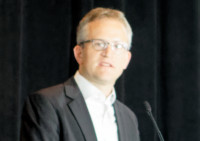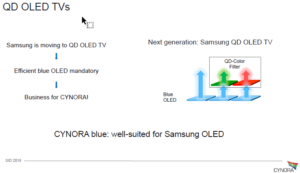 Dr. Andreas Haldi is CMO from Cynora and is a veteran of Novaled. Cynora is a German company with 100 TADF researchers from 16 countries. It is planning to double its facility to 4,000 m², shortly. Investors in Cynora include LG Display and Samsung.
Dr. Andreas Haldi is CMO from Cynora and is a veteran of Novaled. Cynora is a German company with 100 TADF researchers from 16 countries. It is planning to double its facility to 4,000 m², shortly. Investors in Cynora include LG Display and Samsung.
He started by saying that UDC has good technology for OLED in red and green, but not in blue. Moving to foldable and flexible displays is likely to mean more battery power being needed because of the shape. At the moment, multiple blue layers are needed, to meet the colour requirements which adds cost. Reducing the number of layers reduces the voltage needed and that means power savings.
Cynora thinks that TADF may work with QDs in new TV architectures
Competition from QDs will also impact OLEDs in the future. Haldi said that if you have a blue OLED, you can add red and green via QDs. Many companies have tried to develop efficient blue materials and Ciba gave up and sold to BASF, who also gave up and sold to UDC. Haldi then explained the TADF concept, which provides the efficiency of phosphoresence with the stability of fluorescence.
Cynora is synthesizing around seventy different molecules per month to find the best materials. The company now has the efficiency and the colour that the customers want, but not yet the lifetime.
Currently EQE is 20% with CieY of 0.14 and lifetime is 20 hour. The requirement is 50-100h to 97% output which is the same as current fluorescent blue. Although this is a short time, makers typically have compensation systems to deal with the degradation of the blue.
The company expects to be in production volume by 2020 and that is because the makers want a 12 – 18 month ramp up. Green should be in production in 2021 and red by 2022.
Analyst Comment
The planned release date has slipped from last year. It wouldn’t be a big surprise if development slips even further. (BR)

